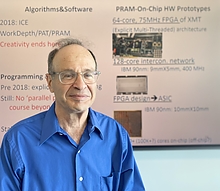Vishkin Featured in Communications of the ACM Point/Counterpoint

A noted University of Maryland expert in parallel computing recently weighed in on the value and efficiency of a new breed of general-purpose processors in an essay published in Communications of the ACM, considered the leading print and online publication for the computing and information technology fields.
Uzi Vishkin, a professor of electrical and computer engineering with an appointment in the University of Maryland Institute for Advanced Computer Studies, offered his thoughts as a counterpoint to an essay from Bill Dally, an adjunct professor at Stanford University and chief scientist and senior vice president of research at Nvidia, a leading manufacturer of graphical processing units (GPUs).
The informative debate was published in the September 2022 issue of the magazine, sent to more than 100,000 members of the Association for Computing Machinery, with scores more reading the publication online.
Both Vishkin and Dally acknowledged that general-purpose processors, known as CPUs (for central processing units) were the main force behind the computing revolution that began in the early 1980s—first with personal computers and continuing with an explosive growth of mobile devices.
But starting nearly 20 years ago, most all CPUs manufactured were comprised of multiple processor cores, known as multicore CPUs. Unfortunately, Vishkin believes, multicore CPUs have not offered a similar growth level as prior-generation CPUs, particularly when it comes to utility and performance for existing applications as well as the introduction of new applications.
This formed the basis of the ACM Point/Counterpoint discussion.
Dally’s piece, “We Must Extend Our Model of Computation to Account for Cost and Location,” focused on electrical power consumption in today’s hardware. He proposed that algorithm and software developers use a model of computation whose primary objective is a decrease in the use of electrical power.
Dally advocated for weighing the cost of memory operation in proportion to distances traversed. Allowing for the true costs of computations, Dally stated, an upgraded model using PECM (parallel explicit communication model) would allow for the design of more efficient computations, resulting in a reduction of computing’s carbon footprint.
Vishkin offered a substantive counterpoint to Dally’s focus on minimizing power as the foremost goal for computer programmers.
Vishkin has spent much of his academic career pursuing innovative advances in parallel computing. Early on, he co-founded the theory of parallel algorithms; later, he was active in developing and prototyping parallel hardware and software for a new computer architecture platform.
His essay, “Parallel Programming Wall and Multicore Software Spiral: Denial Hence Crisis,” looked at basic costs like power consumption that are associated with computing. But Vishkin primarily examined the human factor—the cost-effective programming skills needed to develop application software and make it run flawlessly with little time lost due to software errors. Both are important factors in productivity and ease-of-use for those tasked with writing code for multicore processors.
“The foremost problem of today’s multicore parallelism is dearth of programmers, since programming such systems is simply too difficult,” Vishkin wrote.
While in agreement with Dally’s PECM proposal for a limited number of specialized cases, Vishkin believes that imposing the PECM implied optimizations on most programmers would be an immense undertaking, and therefore would not be practical.
He also notes that he is not aware of any demonstrated success of PECM for general-purpose programming.
The paring of Vishkin and Dally for their point/counterpoint debate was the idea of Moshe Vardi, the Karen Ostrum George Professor of Computational Engineering at Rice University and the senior editor of Communications of the ACM.
Vardi had seen a panel discussion in 2021 at the ACM Symposium on Parallelism in Algorithms and Architectures (SPAA) that included Vishkin, Dally and three other computing experts. That panel was organized by Vishkin in his role as the steering committee chair for SPAA.
Noting that there were “five very different, yet viable, viewpoints” on this subject, Vardi followed back earlier this year with two of the panelists, Vishkin and Dally, and asked for the recent point/counterpoint essays.
In an interview after his op-ed was published, Vishkin made several additional points.
“During the 50-plus years during when serial computing dominated, general-purpose processors were the quintessential form of computing growth,” he says. “But with transition to parallel computing in 2005, it brought about a divergent reality where computing growth was mostly delegated to accelerators like GPUs and other technologies.”
Now, Vishkin concludes, recent computer system research and similar parallel algorithms and programming concepts developed at the University of Maryland suggests that general-purpose processors can once again serve as a backbone platform for computing.
Go here to view a video presentation of the points Vishkin presented in his Communications of the ACM article.
